7 days. Route by car through the Sierra de Tramuntana and day in Palma
From Nativics we have prepared this 7-day car route for you to fully discover the Sierra de Tramuntana, declared a World Heritage Site by UNESCO, and the capital of the island. Thus, with this itinerary you will discover some of the most beautiful towns in the north of Mallorca, such as Valldemossa, Deià, Fornalutx and Sóller, as well as the lively Palma. A city full of life with an exciting historic center and an imposing cathedral facing the sea. This plan 6 nights of accommodation and breakfast in the Sierra de Tramuntana (three hotel nights in the wonderful town of Valldemossa and another three nights in Fornalutx, awarded the title of Most Beautiful Town in Spain) and tickets to the Real Cartuja and to the Municipal Museum of Valldemossa, so you don't have to worry. In short, it has everything you need so that you can discover the Sierra de Tramuntana by car and on your own, but with the certainty that you will not encounter unforeseen unexpected events... In this plan you will also find some recommendations to enjoy your free time in this idyllic Majorcan setting. Are you excited?
Are you interested?
Experience Details
What includes
- Accommodation and breakfast at a hotel in Valldemossa.
- Accommodation and breakfast at a hotel in Fornalutx.
- Entrance to the Royal Charterhouse of Valldemossa that includes church, monastic pharmacy, Palace of King Sancho, museum of Frédéric Chopin and George Sand, Municipal Museum and gardens of King Juan Carlos.
- Piano concert as long as you attend during exhibition hours.
does not include
- Flights (only if this option has been selected in the search engine)
- Rental car
- Pick-up and return service to the hotel
- Other entrance fees not mentioned
- Other transfers not mentioned
- Tour guide
What Brig
Comfortable shoes. Keep in mind that the ground is paved in both Valldemossa and Fornalutx.
If you come outside of the summer months, bring warm clothes and an umbrella.
If you come in summer, a jacket or cardigan in case it cools down at night in Valldemossa, and a swimsuit if your intention is to swim on the beach in Puerto de Sóller.
Driver's license.
Travel guide of 7 days. Route by car through the Sierra de Tramuntana and day in Palma
Day 1: Arrival by car in Valldemossa. Discovering a fairytale town
Valldemossa is only 30 minutes by car, about 27 kilometres, from Palma airport. When you arrive, your room will be waiting for you in one of Valldemossa's fantastic boutique hotels. Take the opportunity to leave your bags and get comfortable before going out to explore some of the places of interest in Valldemossa, the town that has welcomed great artists such as Frédéric Chopin, Rubén Darío, Azorín, George Sand or, recently, the actors Michael Douglas. and Catherine Z Jones. Its cobbled streets and matching traditional houses alone are well worth the walk.
A few meters away, walking you will find the Church of San Bartolomé. This 13th-century church bears the name of the patron saint of Valldemossa, San Bartolomé or, which is the same but in Majorcan, Sant Bartomeu. This Gothic-style parish church with a neoclassical bell tower is open to its parishioners and the general public and admission is free. You can enter during the day to contemplate its white vault, its rose window and its paintings. Although modest, this church is most beautiful and forms the center of the town. In fact, before arriving, you will see its dome from the road. A most idyllic picture.
In front of the Church of San Bartolomé, you will find the birthplace of Blessed Santa Catalina Thomás, < /strong>patron saint of Valldemossa, born in the 16th century. It does not have visiting hours since it has been converted into a chapel in honor of her and some gates protect it. Known as la beateta, Santa Catalina Thomás is the most revered saint in Mallorca as she was the first Mallorcan saint. His remains remain intact in the Convent of Santa Magdalena, in Palma, where he entered at the age of 21. Several miracles are attributed to him, the appearance of saints and the experimentation of the greatest ecstasy in history (21 days). Thus, she was beatified in 1792 and sanctified in 1930.
After visiting the house of "la beateta", we can continue enjoying the cobbled streets, the plants that adorn the houses and reach the Mirador de Sa Miranda des Lledoner. From there you can see spectacular views and, if you feel like it, sit in a bar, cafeteria or restaurant.
What will you see today?
Church of San Bartolomé, Valldemossa
Convent and birthplace of Santa Teresa de Jesús
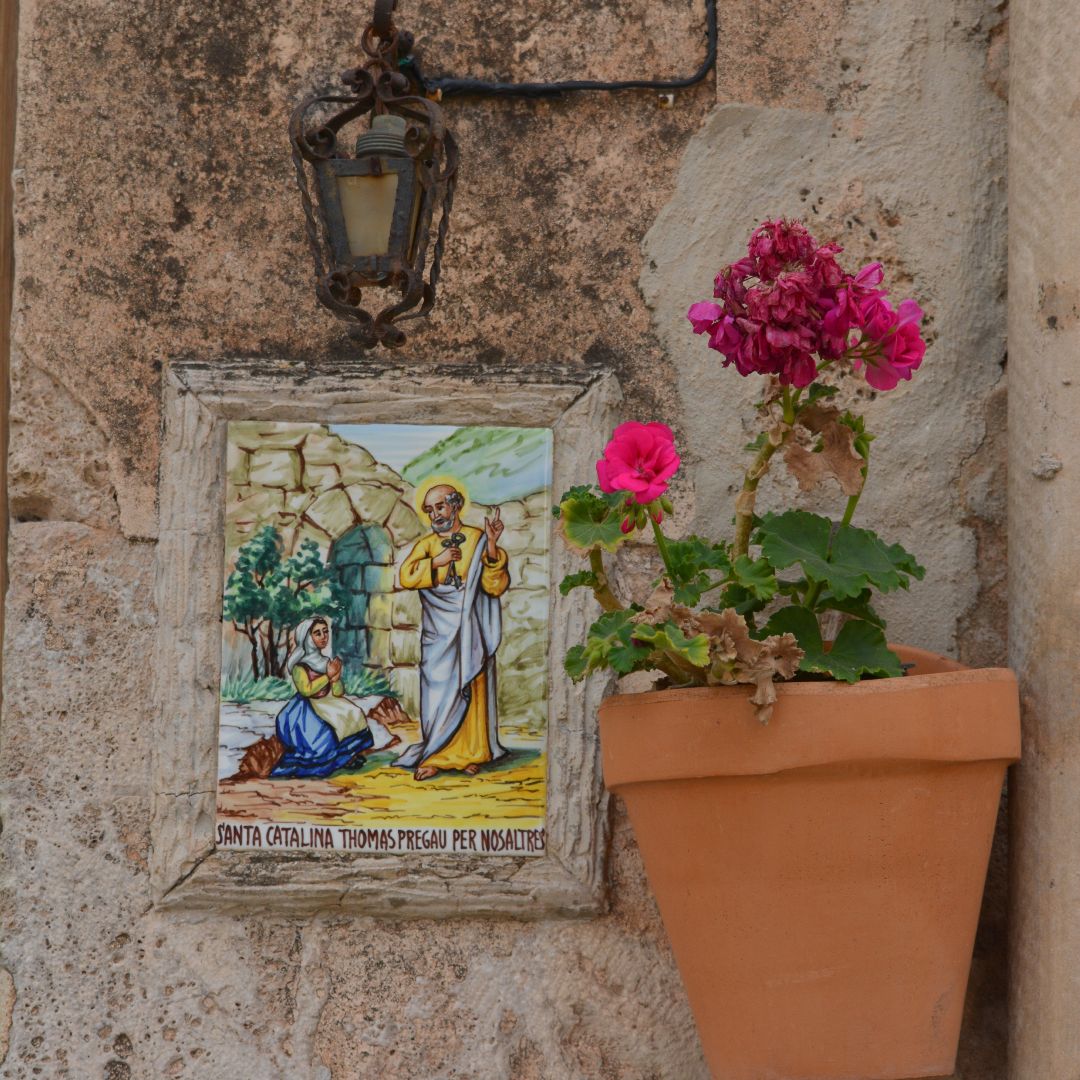
You will find throughout the town of Valldemossa these typical tiles with the inscription "Santa Catalina Thomàs, pray for us" that the townspeople place on the doors of their houses to get the protection of their beloved saint.
Day 2: Visit to the Royal Charterhouse of Valldemossa
After breakfast at your hotel, you can visit the monumental complex of the Real Cartuja de Valldemossa. With its green dome, it has been a refuge for great artists and personalities. Pianist Frédéric Chopin spent his last days here, in one of the Carthusian cells, where he composed some of his works and where his piano is still kept. In the complex you can enjoy the Palacio del Rey Sancho and the concert hall, where since 1932 it is exhibited where the musician himself played. In fact, throughout the morning, there are several piano performances, included in the ticket that we have reserved for you. In addition, the ticket also includes a visit to the Church of the Charterhouse, the old monastic pharmacy, belonging to the (Carthusian) monks, the Frédéric Chopin and George Sand, and the Valldemossa Municipal Museum, divided into four sections: an exhibition of the old Guasp printing press, one of the best preserved in Europe, and a collection of 1,590 xylographic matrices from the 16th to 19th centuries; a room for the Archduke Luis Salvador of Austria; a room of works by painters who were inspired by this part of the island, the Serra de Tramuntana and, finally, a collection of Contemporary Art. To finish, nothing better than strolling through the Jardines del Rey Juan Carlos and sit down to rest. If you are looking for a place to eat or dine, both at the Sa Miranda viewpoint, as well as in Vía Blanquerna and Calle Uetam, you will find a wide variety of options. This town is small so everything is very close, it's a matter of walking and sitting in the place you like the most.
You can spend the afternoon to do some shopping in the little shops that you will find along the promenade or simply to stroll and enjoy a good terrace. But, of course, you cannot leave without trying the famous coca de patata, traditional from Valldemossa. Our recommendation is that you sit down for a quiet snack and order this sweet bun with a cup of chocolate.
What will you see today?
Royal Charterhouse of Valldemossa
Frederic Chopin composed Preludes Op.28, while his wife, George Sand, wrote the internationally famous book A winter in Majorca, during his stay in the Charterhouse. >whose prologue was written by Robert Graves, a British writer and resident of the neighboring town of Deià. A great inspiration for both of them if we take into account that they only enjoyed the Mallorcan paradise for 95 days.
Day 3: Visit to Palma from Valldemossa
In the morning, a good option is to go from Valldemossa by car to Palma, so you can discover this city full of life and history. The first recommendation is that you go to see the Cathedral of Santa María, known by Majorcans as la Seu. Declared a Historic-Artistic Monument in 1931, the cathedral of Mallorca is located in a privileged location, facing the sea, and is of incomparable beauty, not only because it has the largest rose window in the Gothic world, but also because of its built structure in three naves and its huge gates, which do not lack detail.
Under the cathedral, you can walk through the Parc de la Mar, a park with a large saltwater lake. This park is the epicenter of a wide variety of events and concerts and is located in front of the medieval walls that surround the entire area. At the foot of the cathedral, next to the Parc de la Mar, there is also s'Hort des Rei, a small garden with a Muslim arch and a pond from which various fountains emerge along the length, reminiscent of to the gardens of the Generalife of the Alhambra but in miniature. In these gardens you can take the opportunity to sit down to rest or take photos. Of course, do not miss the lake that is located between the walls and that is home to two swans, much loved by the people of Palma and, above all, by children.
Yes lunchtime is approaching, we recommend that you do it in the La Lonja area where there are a wide variety of restaurants along its small alleys and take the opportunity to visit the civil Gothic building of La Lonja, built due to the great commercial activity that was in the port of Palma. Here merchants met and trade agreements and banking operations were carried out. It currently hosts temporary exhibitions and admission is free. It is closed at noon, so if you want to visit it, it is better to do it in the morning or in the afternoon.
To end the afternoon, nothing better than walking around the Borne> and makeshopping in Jaime III, the urban center par excellence for Mallorcans. There you will also find many cafes and bars as well as a Spanish department store. If you feel like having a typical snack, we recommend that you order a llonguet. It is a type of sandwich made with a typical roll from the city of Palma. In fact, people from Palma are called “llonguets” and the sandwich made with this bread is known as “llagosta”, lobster in Majorcan. That's because they say it's hotter than that crustacean. The favorite of most Mallorcans is the llonguet or sobrassada lobster, although there are all kinds of them: cheese, Serrano ham, squid, Mallorcan fried... and the most emblematic place to eat them is in the mythical Barc Bosch, open since 1936. If you have time, you can get lost in the surrounding streets or continue shopping on San Miguel.
Finally, if you want to stay for dinner and a drink in a stylish venue, Palma is an ideal place. On weekends it is very lively and you can even enjoy a good afternoon. An activity that has become fashionable and that consists of starting the party after eating to avoid staying up late. The liveliest areas of Palma are Paseo Mallorca, Paseo Marítimo, la Lonja and our favourite: Santa Catalina. In them you will find restaurants, bars, cafes and places where you can have a drink and listen to good music.
What will you see today?
Cathedral or Seu of Palma de Mallorca
S'Hort del Rei in Palma de Mallorca
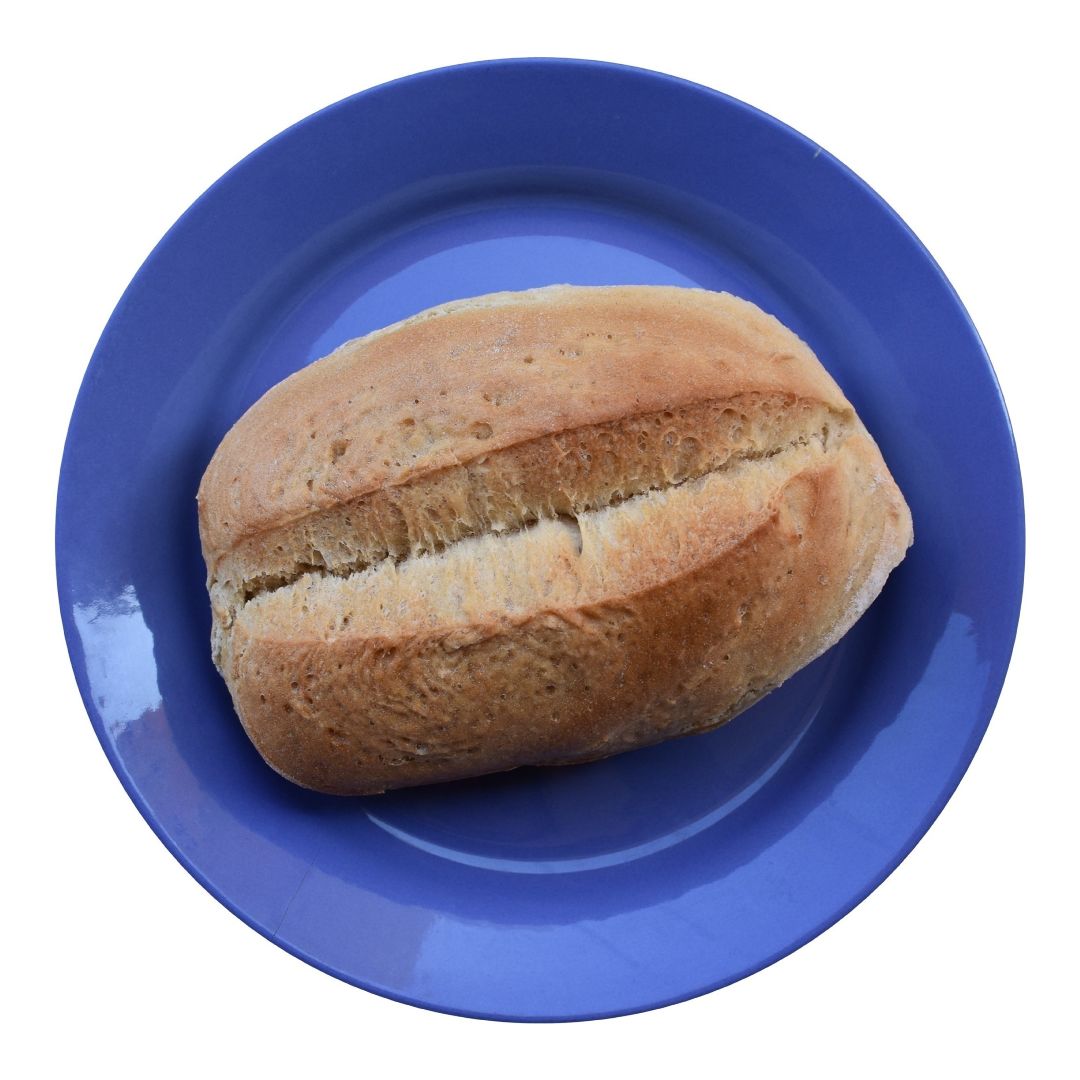
The llonguet, together with the xeixa bread, is one of the varieties of artisan bread that has been made in the Balearic Islands for centuries. So much so, that in recent years they are trying to maintain this tradition by giving it more visibility and promoting it through the "Pa d'aquí" label, (bread from here). Made with sourdough and long fermentation, the llonguet is a crispy white roll on the outside with a longitudinal mark running through it that makes it easily recognizable, and on the inside it contains a fluffy crumb. It is stuffed with a wide variety of sausages, anchovies, squid and even fried Majorcan. On the other hand, xeixa bread is made with xeixa flour, a type of native wheat that had been lost and is now being cultivated again.
Day 4: Fornalutx. Discovering one of the most beautiful villages in Spain
On this fourth day, we will take you to the beautiful town of Fornalutx. Located about 30 km from Valldemossa, this municipality of only 700 inhabitants is located in the Sierra de Tramuntana, in the Sóller valley. To make your stay as comfortable as possible, our team of experts in the area has selected one of the most beautiful and well-located hotels in the municipality.
Once you leave your bags, take the opportunity to get to know this charming town. Stroll through its cobbled alleys and look at the roofs of the houses and you will see that some of them still have their painted tiles. This was something common and traditional in the nineteenth century. XVI in Mallorca and the vast majority are preserved only in Fornalutx and in Sóller, its neighboring town. These tiles were painted by hand in red: geometric figures, plants, elements of daily life, animals and religious themes are some of the compositions that were carried out on the tile in the belief that this protected the home and its inhabitants from external aggressions.
Fornalutx can be considered a municipality of landscape and architectural interest, not in vain it is cataloged as one of the most beautiful towns in Spain as well of having also been awarded for its work of conservation and respect for nature.
Walking through its beautiful streets, you will find the Town Hall, right at the beginning of Carrer Major (Major Street). This town hall is guarded by a defense tower from the 17th century, very well preserved. If you continue with the walk, along this same street, you will come across Plaza España, the center of the town and the main meeting place for the residents of Fornalutx. Here is located the Church of the Nativity of the Mare de Déu, one of the most emblematic buildings in this municipality. Originally from the 13th century, it has been modified over time so it has some features from other times, such as the Gothic portal that leads directly to the cemetery, known as "El Fossar". Although small, this parish preserves in its interior artistic works from the 12th and 13th centuries and, without a doubt, your visit is well deserved. In this same square you will find cafes and restaurants. We recommend that you sit in one of them and relax while contemplating the landscape.
Although Fornalutx is a small town, there are different options for lunch and dinner. From typical Majorcan restaurants to Italian restaurants.
What will you see today?
Church of Fornalutx
Fornalutx defense tower
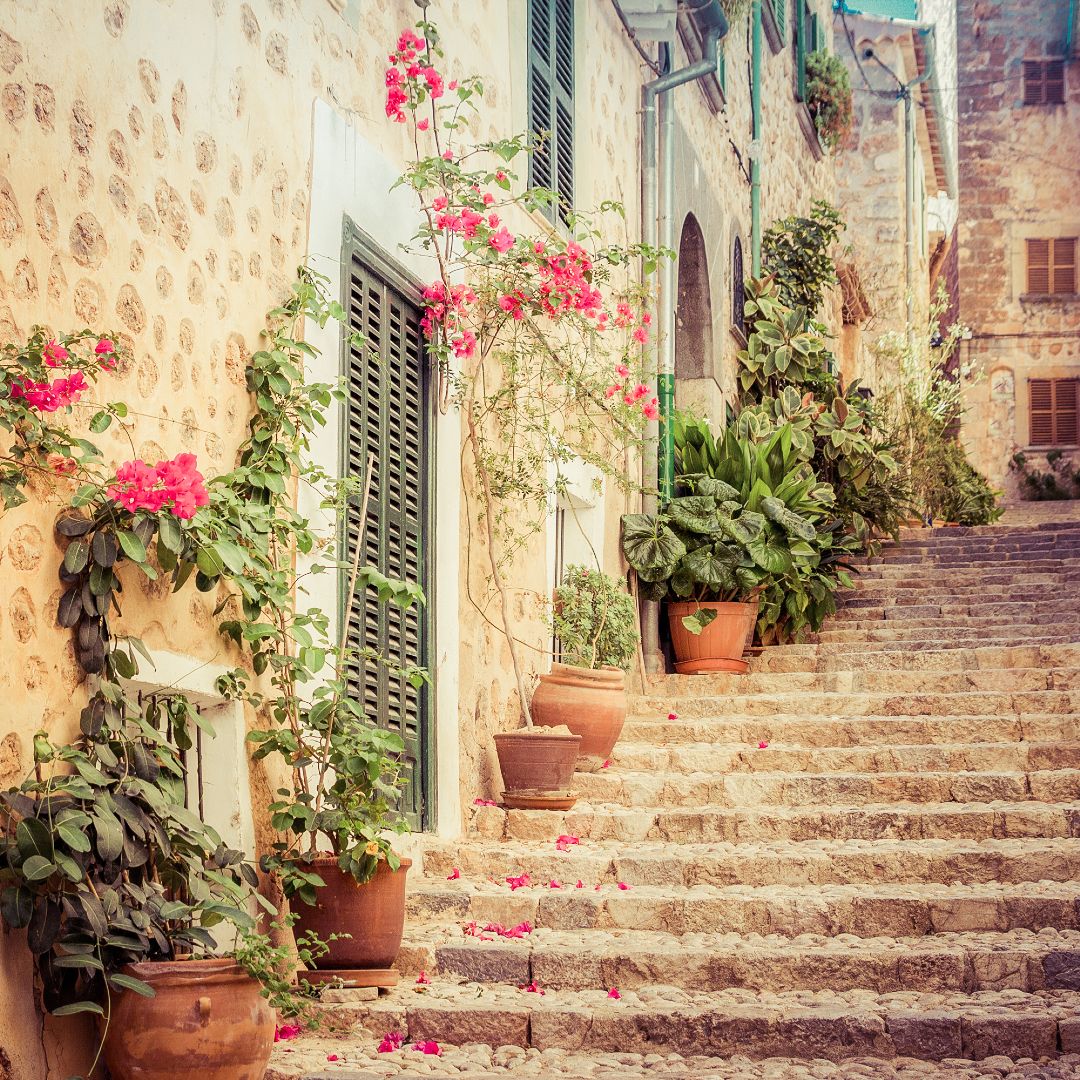
Fornalutx has been awarded as the most beautiful town in Spain. This title is granted by the Spanish association that gives it its name. These awards were created in 2011 to promote, disseminate and promote the cultural, natural and rural heritage of those small municipalities in the Spanish geography with less industrialization and greater conservation of their environment. That a town is cataloged as the Most Beautiful Town in Spain is an honor since they have to meet a series of strict criteria, including having a population of less than 15,000 inhabitants and a certified cultural or natural heritage, and with a process exhaustive assessment, selection and certification.
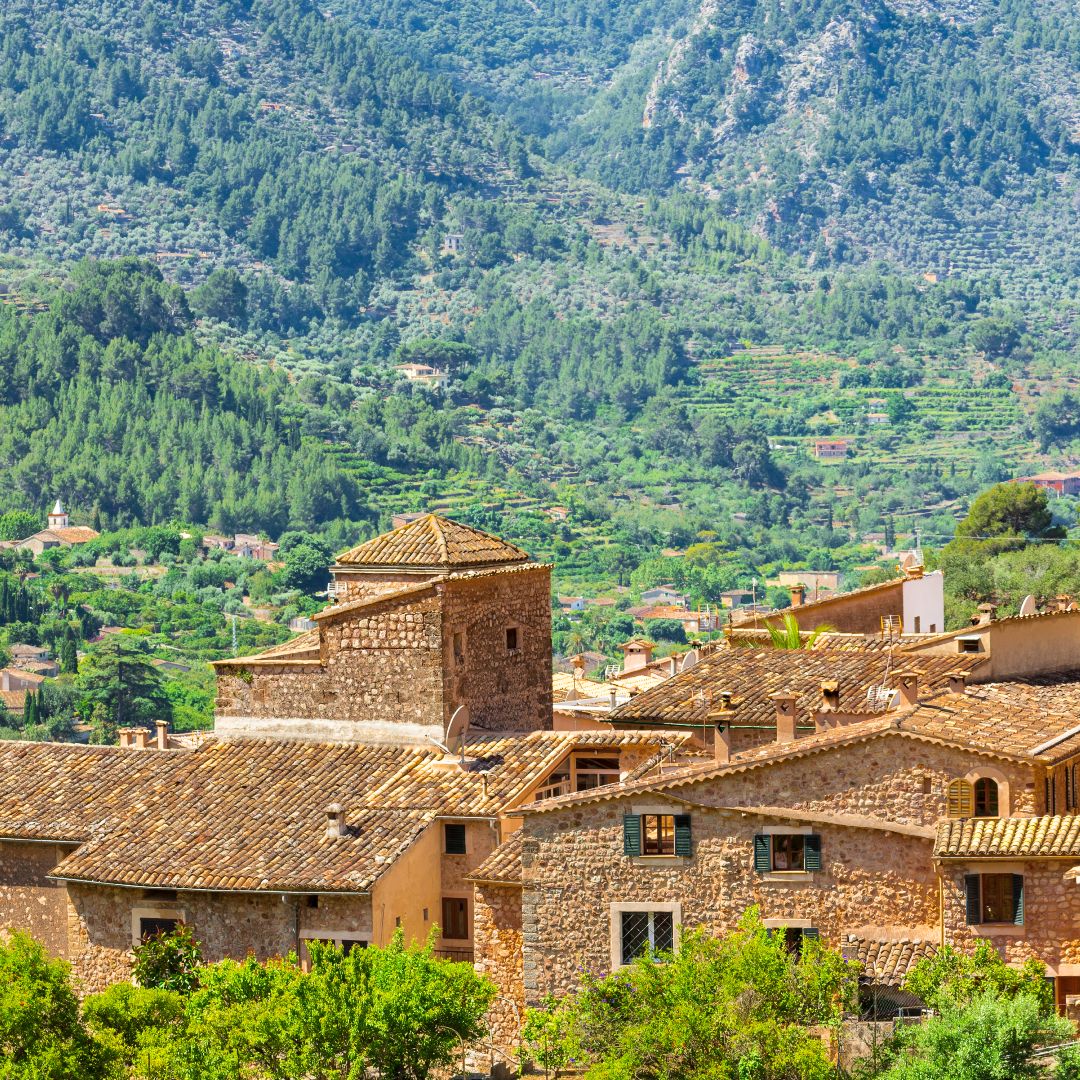
Fornalutx is a small town that has everything close by and the most important thing is not its monuments but the entire town as a whole, so it is important that you get lost in its narrow streets, look at its cobbled houses with their painted tiles, discover dreamy corners, from fountains to a small waterfall and enjoy the nature that surrounds the entire municipality.
Day 5: Fornalutx. Enjoying the most charming town.
If your stay in Fornalutx falls on a Friday or Saturday, you can take the opportunity to visit Ca'n Xoroi, an old Majorcan possession acquired by the City Council in 2002, converted into a museum. If you are interested in visiting it, the hours are from 10:30 a.m. to 1:30 p.m. The entrance is free and you can buy it in the same museum that is not usually very crowded. A most interesting visit since this noble house has an old industrial mill, the last one used in the town, a collection of 278 traditional painted tiles from the place and other surrounding municipalities and from different eras, in addition to also finding the municipal photographic fund.
If what you fancy is to do a little hiking, Fornalutx has some spectacular routes with different levels. Remember that you are in the middle of the Sierra de Tramuntana, a unique place that is part of the Universal Heritage. If you are in good physical shape, you will find routes such as the “Camí de l'Alzina Fumadora”, which lasts about 6 hours, or the “Camí de Sa Costera”, between 4 and 5 hours. These routes are of medium difficulty but consist of 11 and 12 km respectively. If you prefer something calmer and less difficult, we recommend the “Camí de Binibassí” route, an itinerary of only 3km that does not It will take you more than 45 minutes, or the “Camí des Creuer”, with 8 km of route and a duration of no more than 90 minutes. You will find all the information on the website of the Fornalutx Town Hall.
Of course, you can always dedicate yourself to continuing to enjoy Fornalutx, lose yourself in its cobbled streets and enjoy this idyllic town without haste.
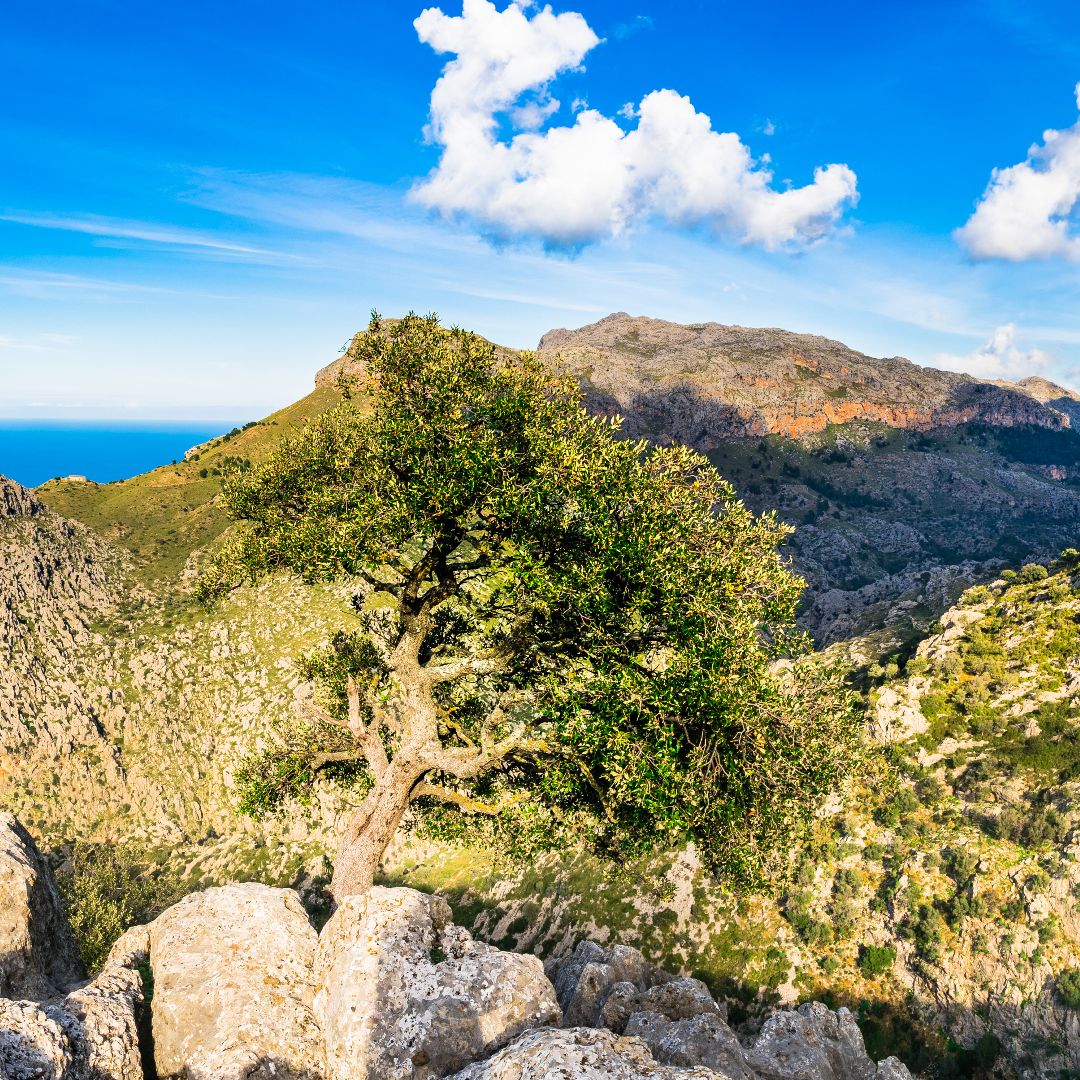
The Sierra de Tramuntana
The Sierra de Tramontana -in Mallorcan, Serra de Tramuntana-, was declared a UNESCO World Heritage Site in 2011. It measures almost 90 kilometers long and is located in the northeast of the island of Mallorca, hence its name since According to the local wind rose, the wind in that area is called the Tramontana wind. This mountainous system is the most important of the Balearic Islands and extends from Andratx to Cap de Formentor. In this mountain range is the Puig Major, the highest mountain in Mallorca.
Day 6: Soller and Port de Soller. Between orange trees and Modernism.
For this day, nothing better than visiting Sóller, the neighboring town of Fornalutx, located just 4 kilometers from Fornalutx. Once you park, you can explore it on foot to discover all its corners. From the center of the municipality, everything is close by so it is easy to walk around it. Let's start our route!
In the heart of Sóller, is the Plaza de la Constitución, place of celebrations and meeting of the sollerics and visitors. In it you will find bars, cafes and restaurants and the Sóller Town Hall, with its characteristic coat of arms. Around the square, guarding it, you will see the imposing Church of Sant Bartomeu, symbol of the city and of Modernism in Spain. This parish is one of the favorites of the Majorcans and one of the most important in the Balearic Islands. Declared a site of cultural interest, its construction began in the 13th century, originally being Romanesque-Gothic in style, but as usual in these constructions, it has undergone variations over the years, hence we also find some Baroque structures. But, without a doubt, the last modification, begun in 1904 and finished in 1946, is what makes the Church of San Bartolomé an icon of the city and an example of wonderful Art Nouveau. It is the spectacular modernist façade, the work of the Catalan architect, Joan Rubió i Bellver, a disciple of the great Antonio Gaudí, with whom he collaborated on other works of great relevance, among others, The Sagrada Familia, Casa Batlló and Parc Güell, in Barcelona. If you are passionate about Modernism and want to see more, the Can Prunera Museum exhibits permanent and temporary works by painters such as Picasso, Kandinsky and Warhol. The entrance general is more than reasonable, five euros for those over 12 years. In addition, there is a special rate for students and pensioners and children enter free. The entrance is acquired in the same museum that, by the way, is not usually very crowded, so you will rarely find queues.
Continuing with our visit to Sóller, to the left of the Church, another of the works of the same architect, Joan Rubió i Bellver. It is the lavish Banco de Sóller. A modernist-style building that, although it now belongs to Banco Santander, reflects the economic splendor of this municipality in the Sierra de Tramuntana, which managed to boost its economy by exporting oranges to Europe, especially France. In fact, many were the locals who emigrated to the Gallic country and returned with great fortunes. And it is that Sóller is a valley of the Tramuntana with an ideal microclimate for growing lemons and oranges. They are not only the best citrus fruits on the island, but they are also one of Europe's favorites. With the famous oranges, all kinds of products are made: jams and preserves, liqueurs, candied oranges, juices... and even ice cream! Because if there is something you have to try in Sóller, it is, without a doubt, its oranges and its artisan ice creams with the label “Gelat Sóller” (ice cream Sóller), the best ice cream in Mallorca. In the center you will find several ice cream parlors, among them, Sa Fàbrica des Gelats, one of the most recommended.
Continuing from Plaza Constitución , you will find the lively Calle de Sa Lluna, a commercial street full of little shops, ideal for doing some shopping. In addition, along it, you can see different buildings of architectural interest. Thus, at number 16, you will find an inn from 1758, Can Prohom, place of residence that the great agricultural owners owned. At number 23 of the same street, you will come across Can Bardí, a traditional Majorcan possession typical of the wealthy gentlemen of Majorca. If you continue walking, at number 50, you will discover the oldest building in Sóller, the Casa de Sa Lluna (House of the Moon), from the 15th century, which stands out for its semicircular arch and the figure of the moon in marés that protrudes above the arch of the entrance door.
Once the purchases have been made and you have seen some important buildings in Sóller, You can sit down to eat at one of the restaurants in the center but, if you prefer to eat in front of the sea, take the opportunity to go to Puerto de Sóller, just 5 kilometers away. Getting there It's very simple, you just have to take the tram that crosses the Plaza de la Constitución itself. This beautiful electric tram has been in operation since 1913 and has remained intact ever since, which makes it in an icon of Sóller. The ticket is bought inside the same tram, both the one to go and the one back, and it is the best way to get to the port. The price is about €7 each way and person and it runs every 30 minutes. If you don't feel like taking the tram, you can always go by car. It is very close and access is easy.
Once you arrive at Puerto de Sóller, you will find a wide variety of restaurants along along the promenade and souvenir shops and other typical craft products of Mallorca. If you feel like taking a dip in the summer, there is also a small beach in the port. This area is very lively in summer and is a perfect option to end your visit to Sóller.
What will you see today?
Constitution Square, Soller
Church of Sant Bartomeu de Soller
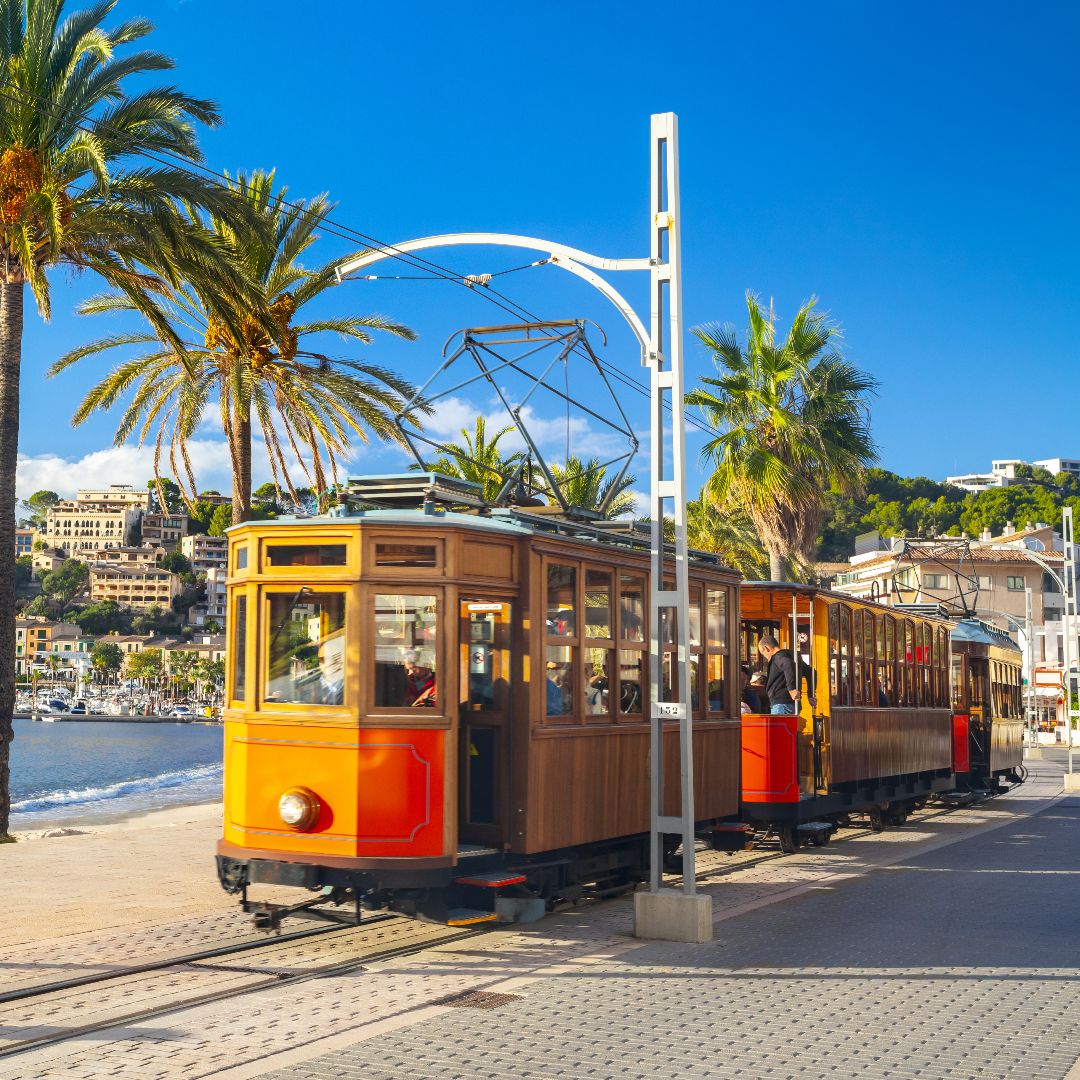
The Sóller tram was the first electric tram in Mallorca. It was manufactured in 1913 to unite the town with the Port of Sóller. Initially it was designed for the transport of passengers but the needs and the great commercial activity of the time meant that it was also used for the transport of goods, including even an isothermal wagon to transport the fish from the port to the center of Sóller.
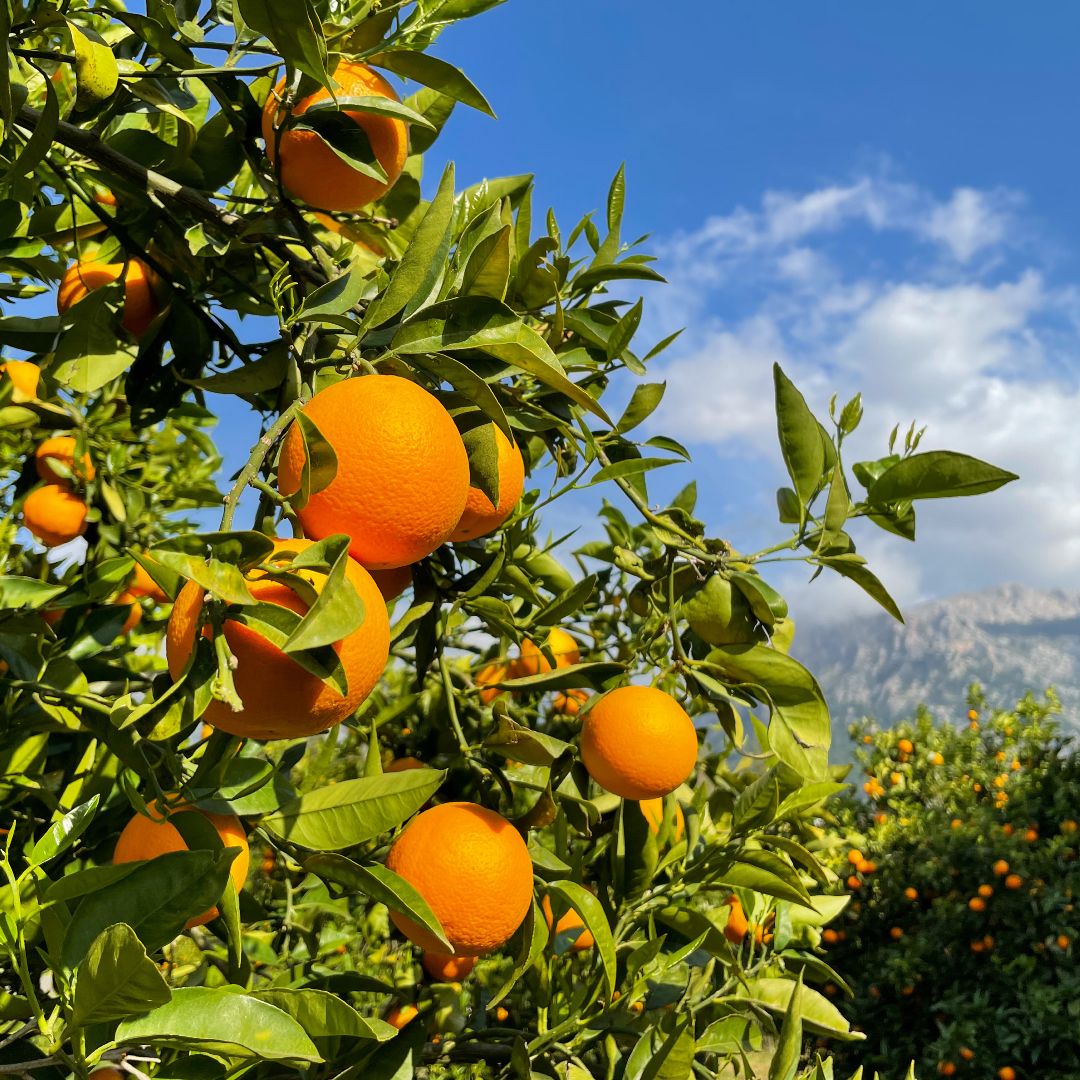
Typical products of Sóller
Artisan ice cream with the "Fet a Sóller" seal.
Oranges and lemons from Sóller.
Orange liqueur.
Red prawn from Sóller, an authentic delicacy.
Olive oil from the Sóller valley.
Day 7: Farewell and return home
Last day of the holidays… Our recommendation is that you get up, have breakfast at the hotel and enjoy the privileged environment in which you find yourself. Afterwards, if you have time, take the opportunity to stroll through your favorite places in Fornalutx or to do the latest shopping. If your intention is to take a typical sweet back home, our recommendation is that you order it a day before so that they have it ready for you. Do not forget to tell them that it is to take on the plane. This way you will avoid problems at the airport.
Finally, remember to leave early enough to avoid possible setbacks such as traffic jams on the road or queues at airport security controls. Keep in mind that you will have to return the rental car first, so it is advisable to arrive at the airport 2 hours before the flight.
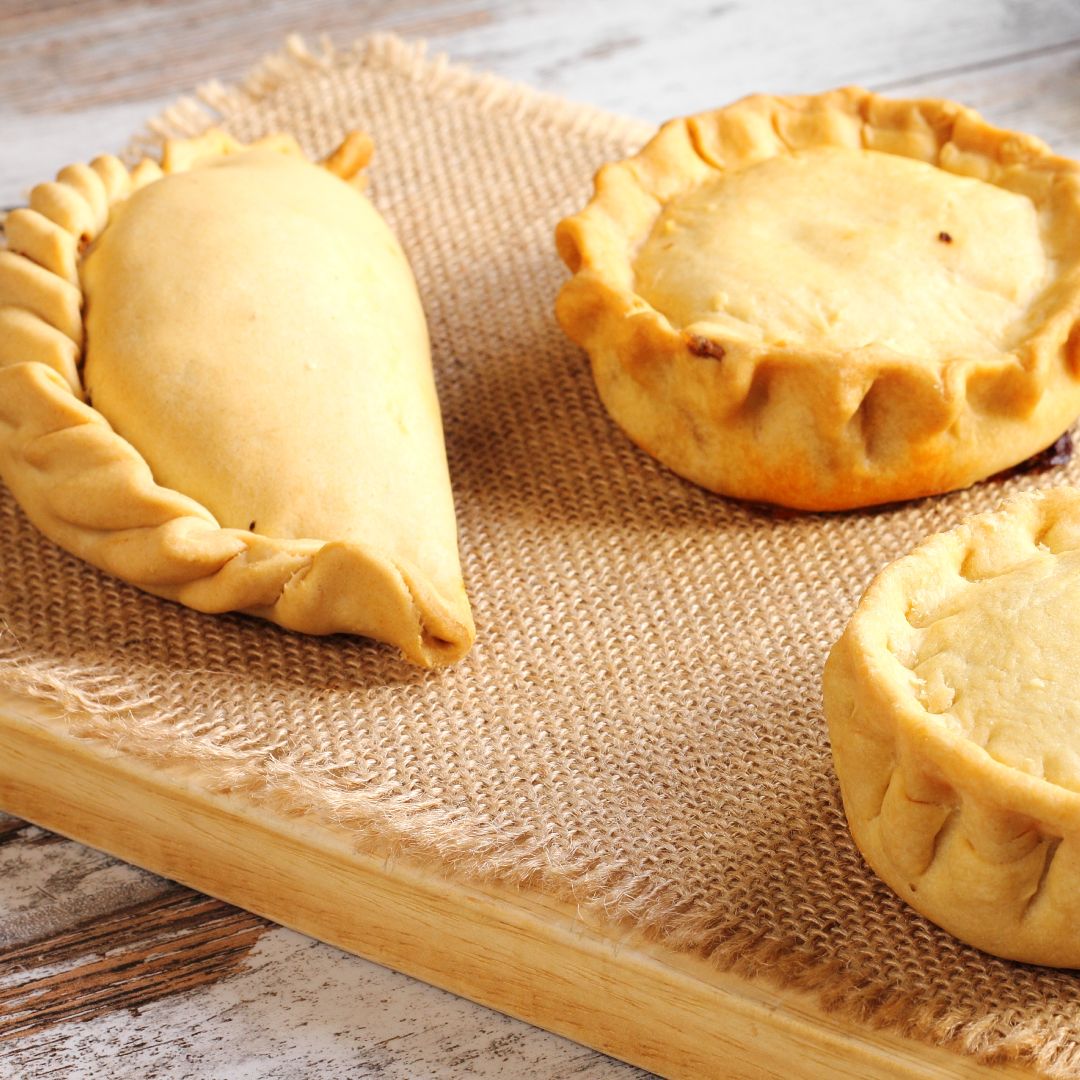
Typical products and dishes of Mallorca
Typical products to take home:
Ensaïmada, coca de cuarto, robiols and crespells.
Empanadas, cocarrois and coca de trampó.
Oil crackers.
Sobrassada, butifarrones and camaiot.
Denomination of origin wine.
Herbal liqueur, palo liqueur and Amazonas rum.
Some fabulous dishes of the gastronomy of Mallorca:
"Arroz Brut"
Sopas mallorquinas
Snails with alioli
Frito mallorquín, frito de matanzas y frito marinero.
Variat (a kind of variety of tapas on the same plate).
Tumbet
Loin with cabbage
Majorcan-style fish, baked and with seasonal vegetables.
Escaldums, typical Majorcan poultry stew with sauce and chopped almonds.
Roasted porcella (roasted suckling pig)
Desserts: cottage cheese greixonera, gató with almond ice cream, cardinal from Lloseta.
Contact an expert
If you have any questions about this experience, if you want more details or if you want to customize your trip, don't wait any longer! Contact us and we will help you tailor your trip.
Contact us if you need to add flights, rental cars, transfers or events to your trip. We will solve all your doubts and we will help you finalize your reservation.
